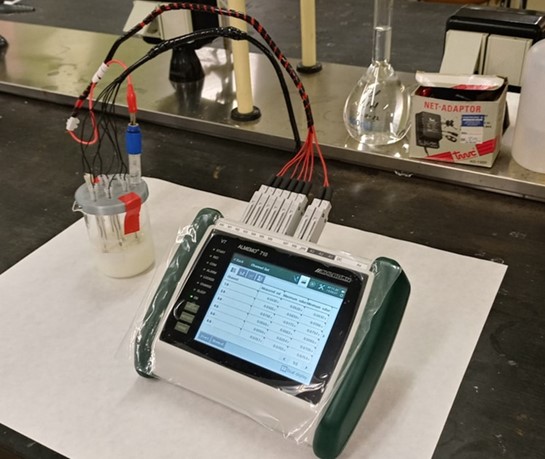Começamos a análise da vindima de 2023
A Estação Enológica de Rueda voltou a ser palco de uma nova reunião do projeto MINORSENS. Durante o encontro, o Instituto Tecnológico Agrícola de Castela e Leão forneceu amostras de uvas, mosto e vinho da colheita de 2023 das variedades minoritárias à Universidade de Valladolid e ao Instituto Politécnico de Bragança para análise. Iniciámos, assim, a próxima etapa de caracterização físico-química desta primeira remessa de uvas das variedades minoritárias, mostos e vinhos produzidos no ano passado, 2023. Além disso, acordámos um protocolo homogéneo para o descongelamento das amostras e tivemos a oportunidade de provar uma pequena seleção de vinhos produzidos a partir das variedades: Puesta en Cruz (proveniente de Arribes, vinho branco elaborado em 2023), Gajo Arroba (proveniente de Arribes, vinho tinto elaborado em 2023) e Tinto Jeromo (também proveniente de Arribes, vinho tinto elaborado em 2023).

MINORSENS e tecnologia: o nariz e a língua eletrónicos
Uma das inovações do projeto MINORSENS reside na utilização de métodos eletrónicos para a análise de mostos e vinhos, algo que até agora tem sido feito através de métodos físico-químicos convencionais e sensoriais. Mas… em que consistem exatamente essas ferramentas?
O nariz eletrónico baseia-se numa rede de sensores resistivos que contam com hardware específico e software que permite reconhecer padrões. O objetivo é analisar os compostos orgânicos voláteis dos mostos e vinhos, imitando de forma simplificada o sistema olfativo dos mamíferos. Faz parte de uma área de investigação chamada biomimética, ou seja, aplicar esquemas de funcionamento próprios da natureza a ferramentas eletrónicas criadas pelos seres humanos. O objetivo deste dispositivo é obter medições objetivas que não dependam da subjetividade humana. A sensação que um odor nos provoca e o significado que o nosso cérebro interpreta automaticamente podem, de alguma forma, distorcer a análise olfativa de um vinho.
Os sensores utilizados pelo nariz eletrónico baseiam-se em óxidos metálicos. São necessários vários desses sensores porque cada um é capaz de analisar um único odor ou componente da amostra. Durante o desenvolvimento do projeto, serão escolhidos os sensores mais adequados para detectar os componentes presentes no espaço à frente dos mostos e vinhos selecionados. Além disso, será avaliado o funcionamento das fibras responsáveis pela absorção dos componentes voláteis.

Por sua vez, a língua bioeletrónica também é um sistema biomimético inspirado, neste caso, pelo sentido do paladar. Utiliza uma rede inovadora de nanosensores e nanobiosensores eletroquímicos capazes de detetar compostos como açúcares, fenóis, polifenóis e ácidos orgânicos. O teor de polifenóis do vinho é um parâmetro importante no setor vitivinícola. Este tipo de substâncias apresenta atividade antioxidante, ou seja, ajuda a neutralizar os radicais livres e protege as células dos danos oxidativos. Isto significa que os polifenóis podem prevenir o envelhecimento prematuro e reduzir o risco de sofrer certas doenças. Do ponto de vista da qualidade, os polifenóis conferem ao vinho a sua cor, textura, amargor e adstringência, pelo que quantificá-los é fundamental para controlar o tipo de vinho que queremos produzir.
Tal como o nariz eletrónico, a língua bioeletrónica utiliza um software de reconhecimento de padrões no qual são implementadas técnicas quimiométricas supervisionadas e não supervisionadas. Graças à língua bioeletrónica, poderemos analisar a qualidade dos mostos e dos vinhos de forma objetiva e estabelecer correlações com parâmetros químicos. No futuro, a língua bioeletrónica poderá ser um dispositivo portátil utilizado nas adegas como mais uma ferramenta de trabalho que ajuda a garantir a qualidade e as características únicas dos vinhos.